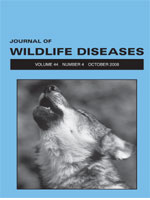Leptospirosis has been reported in California sea lions (Zalophus californianus) since 1970; however, the source of infection and mode of transmission remain unknown. To elucidate these features, demographic and environmental risk factors for leptospirosis were evaluated. California sea lion stranding records from northern California for 2004 were used to identify cases of leptospirosis (n=316) and controls (n=143). Demographic characteristics (age class, sex) and environmental factors, representing surrogates for exposure to dogs, cattle, rainfall, and freshwater sources, were compared between cases and controls with the use of a geographic information system (GIS) and logistic regression. Multivariate analyses revealed that summer and autumn seasons, juvenile age class, male sex, high dog-park density, and close proximity to dog parks were significantly associated with leptospirosis in sea lions, whereas county farmland cattle density, rainfall levels 30 days prior to stranding, human density, and proximity to freshwater sources were not associated. Thus, dogs and dog parks, or factors associated with them, might be further investigated to assess their relationship to leptospirosis in sea lions.
How to translate text using browser tools
1 October 2008
RISK FACTORS FOR AN OUTBREAK OF LEPTOSPIROSIS IN CALIFORNIA SEA LIONS (ZALOPHUS CALIFORNIANUS) IN CALIFORNIA, 2004
Stephanie A. Norman,
Ronald F. DiGiacomo,
Frances M. D. Gulland,
John Scott Meschke,
Mark S. Lowry

Journal of Wildlife Diseases
Vol. 44 • No. 4
October 2008
Vol. 44 • No. 4
October 2008
California sea lion
Case-control study
epidemiology
Geographic Information System
leptospirosis
outbreak
Zalophus californianus




